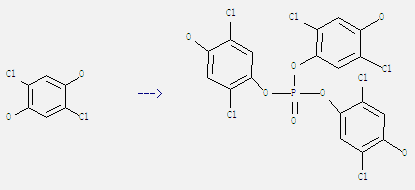-
Name
2,5-DICHLOROHYDROQUINONE
- EINECS 212-533-8
- CAS No. 824-69-1
- Article Data42
- CAS DataBase
- Density 1.624 g/cm3
- Solubility
- Melting Point 168-171 °C(lit.)
- Formula C6H4Cl2O2
- Boiling Point 274 °C at 760 mmHg
- Molecular Weight 179.003
- Flash Point 119.5 °C
- Transport Information
- Appearance almost white to pink-brown crystalline powder
- Safety 26-27-36/37/39-45
- Risk Codes 34
-
Molecular Structure
-
Hazard Symbols
 C
C
- Synonyms Hydroquinone,2,5-dichloro- (6CI,7CI,8CI);2,5-Dichloro-1,4-dihydroxybenzene;2,5-Dichloro-1,4-hydroquinone;2,5-Dichloro-4-hydroxyphenol;2,5-Dichloro-p-benzohydroquinone;2,5-Dichloro-p-hydroquinone;2,5-Dichlorohydroquinone;NSC 48667;
- PSA 40.46000
- LogP 2.40460
2,5-Dichlorohydroquinone Specification
The 2,5-Dichlorohydroquinone is an organic compound with the formula C6H4Cl2O2. The IUPAC name of this chemical is 2,5-dichlorobenzene-1,4-diol. With the CAS registry number 824-69-1, it is also named as 1,4-Benzenediol, 2,5-dichloro-. The product's categories are Organic Building Blocks; Oxygen Compounds; Polyols. It is almost white to pink-brown crystalline powder which should be sealed in the container and stored in the cool and dry place which must be away from oxidant.
The other characteristics of this product can be summarized as: (1)ACD/LogP: 2.33; (2)# of Rule of 5 Violations: 0; (3)ACD/LogD (pH 5.5): 2.33; (4)ACD/LogD (pH 7.4): 2.22; (5)ACD/BCF (pH 5.5): 34.53; (6)ACD/BCF (pH 7.4): 27.15; (7)ACD/KOC (pH 5.5): 438.73; (8)ACD/KOC (pH 7.4): 345.03; (9)#H bond acceptors: 2; (10)#H bond donors: 2; (11)#Freely Rotating Bonds: 2; (12)Polar Surface Area: 18.46 Å2; (13)Index of Refraction: 1.642; (14)Molar Refractivity: 39.8 cm3; (15)Molar Volume: 110.1 cm3; (16)Polarizability: 15.78×10-24 cm3; (17)Surface Tension: 61.8 dyne/cm; (18)Density: 1.624 g/cm3; (19)Flash Point: 119.5 °C; (20)Enthalpy of Vaporization: 53.3 kJ/mol; (21)Boiling Point: 274 °C at 760 mmHg; (22)Vapour Pressure: 0.00332 mmHg at 25°C.
Preparation of 2,5-Dichlorohydroquinone: It can be obtained by 2-chloro-[1,4]benzoquinone. This reaction needs reagent HCl and solvent benzene at temperature of 20 °C. The reaction time is 40 min. The yield is 91%.
![2,5-Dichlorohydroquinone can be obtained by 2-chloro-[1,4]benzoquinone](/UserFilesUpload/Preparation of 2,5-Dichlorohydroquinone.gif)
Uses of 2,5-Dichlorohydroquinone: It can be used to produce tris(2,5-dichloro-4-hydroxyphenyl) phosphate. This reaction needs reagents PCl5, H2O and solvent benzene by heating. The reaction time is 30 min. The yield is 100%.

When you are using this chemical, please be cautious about it as the following:
It can cause burns. In case of contact with eyes, rinse immediately with plenty of water and seek medical advice. After using it, take off immediately all contaminated clothing. If you want to contact this product, you must wear suitable protective clothing, gloves and eye/face protection. In case of accident or if you feel unwell, seek medical advice immediately (show the label whenever possible.)
People can use the following data to convert to the molecule structure.
1. SMILES:Clc1c(O)cc(Cl)c(O)c1
2. InChI:InChI=1/C6H4Cl2O2/c7-3-1-5(9)4(8)2-6(3)10/h1-2,9-10H
3. InChIKey:AYNPIRVEWMUJDE-UHFFFAOYAH
Related Products
- 20,22-DIHYDRODIGITOXIN
- 20,29,30-Trinorlupane,(17alpha)-
- 20-ETHYL-6-β,8-DIHYDROXY-1-α-METHOXY-4-METHYLHETERATISAN-14-ONE
- 20-Ethylprostaglandin F2-alpha
- 20-Isopropylcholanthrene
- 20-METHYLCHOLANTHREN-15-ONE
- 20-METHYLCHOLANTHRENE PICRATE
- 20-METHYLCHOLANTHRENE-TRINITRO-BENZENE
- 20(S)-Ginsenoside C-K
- 2,10-DIFLUOROBENZO(rst)PENTAPHENE
- 82469-79-2
- 82472-59-1
- 824-72-6
- 82473-24-3
- 82475-65-8
- 824-75-9
- 82476-12-8
- 82477-61-0
- 82477-67-6
- 82477-68-7
Hot Products
About|Contact|Cas|Product Name|Molecular|Country|Encyclopedia
Message|New Cas|MSDS|Service|Advertisement|CAS DataBase|Article Data|Manufacturers | Chemical Catalog
©2008 LookChem.com,License: ICP
NO.:Zhejiang16009103
complaints:service@lookchem.com Desktop View